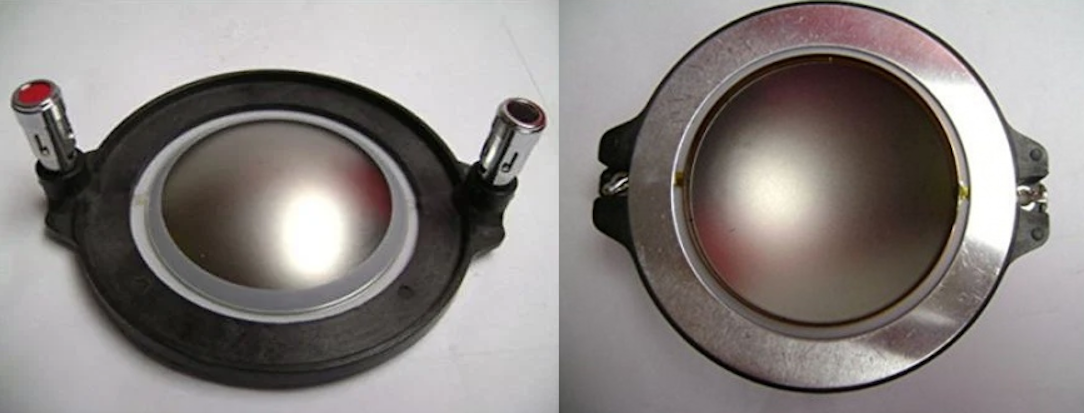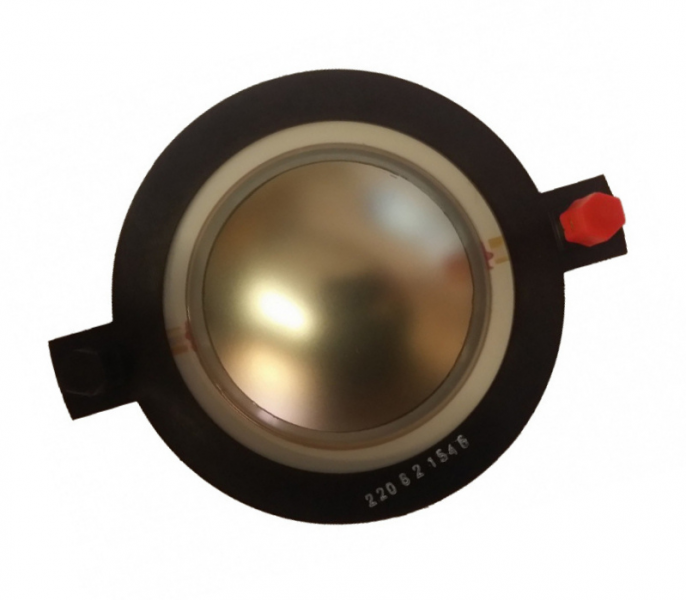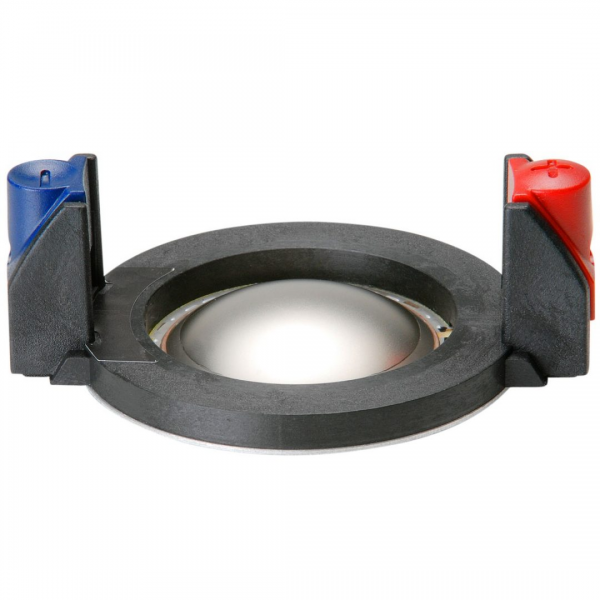I have a round spherical horn in one speaker and in the other I have round Tractrix or Iwata 600 from hOrns in Poland OR the 18 sound XT1464, which is an ellipsoidal horn. My compression drivers of choice are Beyma CP350TI and CP755TI depending on the horn.Not necessarily.
I like shortened axisymmetric (spherical) horns, according to Manfred Harsdorff's work for Zeiss Ikon (Siemens Klangfilm).
Definitely not the DE250, (much) better 1" drivers are available.
An example:
View attachment 121176View attachment 121177
Atma-Sphere Class D Mono blocks
- Thread starter Chorus
- Start date
You are using an out of date browser. It may not display this or other websites correctly.
You should upgrade or use an alternative browser.
You should upgrade or use an alternative browser.
Hiraga was not talking about 2nd or 3rd harmonic per se. He was talking about the distortion pattern caused by the transfer function of the amp. This is also addressed by Cheever and Geddes. A monotonic pattern (exponential decay of successively higher order components) is the preferred pattern. That means not odd dominated but also not odd absent and especially not even absent. Keith Howard found something similar, he added distortion patterns digitally to a music file. He found that the worst was all odd, then all even and the best was the lower of two levels of even and odd in an exponential decay…of course no added distortion sounded the best…but a distortion less amp doesn’t exist.Hiraga is simply wrong about the 2nd and the proof of this is easy to find: A good, properly functioning tape machine will have as its dominant distortion product the 3rd harmonic. It is for this reason that many digital studios will have an analog tape machine on hand to run the recording through to add some 'warmth'.
I've noticed that no-one really complains about reel to reel tape machines- in fact they have an ardent following and people are scouring the countryside looking for R2R machines to refurbish...
What is important is that the 3rd harmonic not be as high in amplitude as the 2nd usually is in an SET. Rather, you want the 3rd to be no more than the level seen in an SET (if the circuit is open loop) and preferably lower. Tape machines and fully differential balanced triode amplifiers accomplish this with ease. In the case of the latter, due to the cubic non-linearity express (rather than the quadratic of the SET) the succeeding harmonics fall off at a rate superior to the Cheever ideal, since a different exponent is in play.
When Hiraga was making his observations, the sort of circuit I'm talking about (fully differential balanced triode amplifier) didn't exist. Lacking an example, his observations are simply out of date. Technology marches on, like it does.
The class D amps we make tend to have a larger 2nd harmonic compared to the 3rd than is seen in our tube amps although the distortion is overall lower.
Boyk and Sussmann demonstrated mathematically that a differential amp will suppress even harmonics…not desirable. Tape decks distortion pattern is primarily determined by the output amp topology, which is primarily push/pull of some kind, which suppress even harmonics when adjusted for lowest distortion. Feedback will suppress lower orders but creates new higher order harmonics (Boyk found some weird things happened in MOSFET simulation making larger harmonics of high order). Was there ever a tape machine with a single ended and not push pull output stage? If not , then I guess we won’t know if tape could sound better still.
My own listening experience agrees pretty strongly with Mr. Hiragas findings…so I don’t agree he was simply wrong…I am also not one who thinks tape is the holy grail of sources…I have heard good and bad like all sources. I made some nice recordings on R2R tape of live classical events but good digital ones too.
AutoTech horns, designed by J. Zagaya in close cooperation with Jean Michel Le Cléac'h.I have a round spherical horn in one speaker and in the other I have round Tractrix or Iwata 600 from hOrns in Poland OR the 18 sound XT1464, which is an ellipsoidal horn. My compression drivers of choice are Beyma CP350TI and CP755TI depending on the horn.
Those Beyma drivers are nice. Earlier this year I was tempted to score a pair of CP350s. The Mk1 version with Aluminum diaphragms, of which replacements are hard to get by.
I'm familiar with the XT1464 as well and the ND1460A is one of my favorite drivers, because of the diaphram (with PEN suspension):
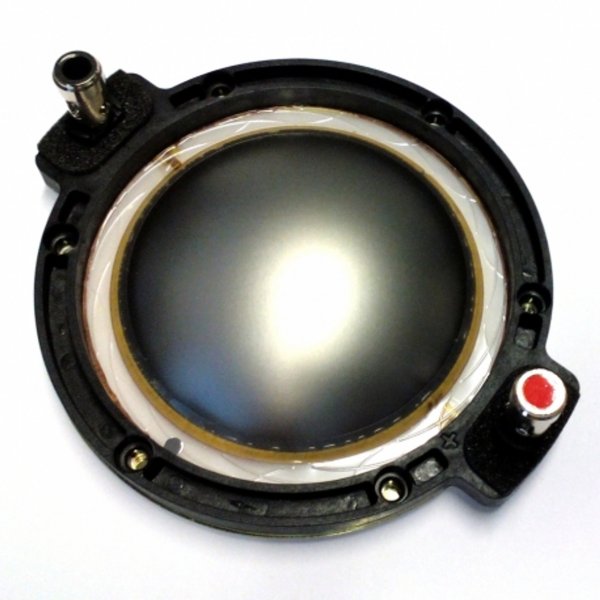
Somewhat similar to the later diaphragms used in the Vitavox S2:
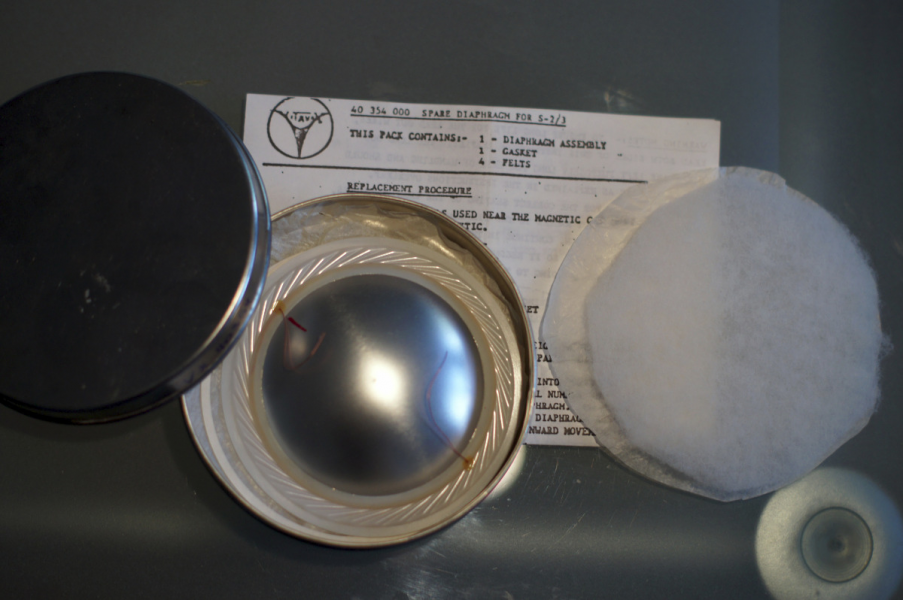
Though not as good as the diaphragm of (most likely) the best large format compression driver available in the world today ($8.000 each):
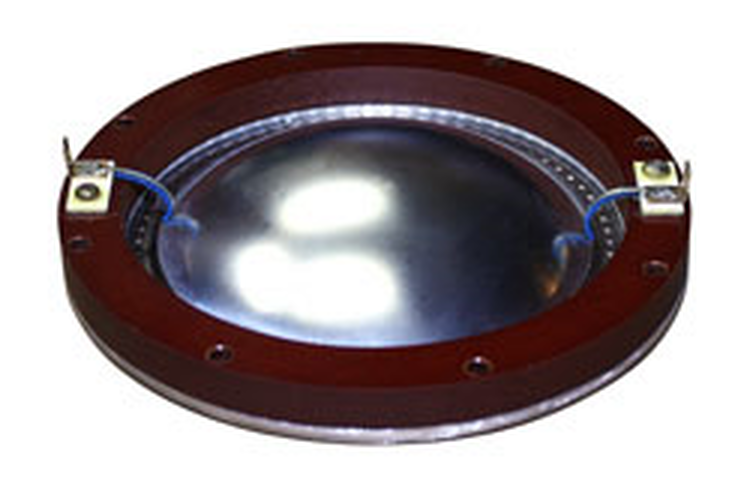
Last edited:
Keith Howard found something similar, he added distortion patterns digitally to a music file. He found that the worst was all odd, then all even and the best was the lower of two levels of even and odd in an exponential decay…of course no added distortion sounded the best…but a distortion less amp doesn’t exist.
Funny you mention Keith Howard. I just re-read his review of the Grimm LS1 and fully agree with his comments. Apart from the (smart) baffle shape, it's a ridiculously expensive system that doesn't draw you into the music.
The CP-350Ti is actually quite a bit better from the measurements...it is a very even driver from a FR perspective. It also doesn't have a massive breakup like you normally see with Ti diaphragms...sounds like it measures...smooth. The larger (1.4 inch) CP755Ti has a Ti diaphragm with mylar suspension...it also measures very smooth and sounds that way.AutoTech horns, designed by J. Zagaya in close cooperation with Jean Michel Le Cléac'h.
Those Beyma drivers are nice. Earlier this year I was tempted to score a pair of CP350s. The Mk1 version with Aluminum diaphragms, of which replacements are hard to get by.
I'm familiar with the XT1464 as well and the ND1460A is one of my favorite drivers, because of the diaphram (with PEN suspension):
View attachment 121203
Somewhat similar to the later diaphragms used in the Vitavox S2:
View attachment 121204
Though not as good as the diaphragm of (most likely) the best large format compression driver available in the world today ($8.000 each):
View attachment 121205
I had the same impression the few times I have heard it...somehow unmusical.Funny you mention Keith Howard. I just re-read his review of the Grimm LS1 and fully agree with his comments. Apart from the (smart) baffle shape, it's a ridiculously expensive system that doesn't draw you into the music.
[emphasis added] I agree with this bit, please consider there is always an exponent to exponential decay (hence the term) and cubic works much better than quadratic. As best I can make out, Cheever, Geddes, Hiraga and so on did not have access to amps that expressed the cubic exponent as they do not seem to mention it at all. Boyk and Sussmann are correct but the conclusion "... not desirable" (wherever that came from), is incorrect. The reason is by generating only odd orders, you are working with a cubic function and so you have two advantages:Hiraga was not talking about 2nd or 3rd harmonic per se. He was talking about the distortion pattern caused by the transfer function of the amp. This is also addressed by Cheever and Geddes. A monotonic pattern (exponential decay of successively higher order components) is the preferred pattern. That means not odd dominated but also not odd absent and especially not even absent. Keith Howard found something similar, he added distortion patterns digitally to a music file. He found that the worst was all odd, then all even and the best was the lower of two levels of even and odd in an exponential decay…of course no added distortion sounded the best…but a distortion less amp doesn’t exist.
Boyk and Sussmann demonstrated mathematically that a differential amp will suppress even harmonics…not desirable. Tape decks distortion pattern is primarily determined by the output amp topology, which is primarily push/pull of some kind, which suppress even harmonics when adjusted for lowest distortion. Feedback will suppress lower orders but creates new higher order harmonics (Boyk found some weird things happened in MOSFET simulation making larger harmonics of high order). Was there ever a tape machine with a single ended and not push pull output stage? If not , then I guess we won’t know if tape could sound better still.
My own listening experience agrees pretty strongly with Mr. Hiragas findings…so I don’t agree he was simply wrong…I am also not one who thinks tape is the holy grail of sources…I have heard good and bad like all sources. I made some nice recordings on R2R tape of live classical events but good digital ones too.
1) distortion falls off at a faster rate as the order of the harmonic is increased
2) the 3rd easily masks those higher orders- better than seen in an SET.
Now if you do some measurements you find something interesting: the odd orders in a circuit like an SET have higher amplitude than you see in the circuit is fully differential as I've pointed out before. Since in both cases, the lower orders are masking the higher orders, the higher orders are inaudible. So which is better at that point, the one with higher distortion or the one lower?? And by lower I mean well over an order of magnitude. Quite often its over two orders of magnitude.
The bit about the tape machines- the third harmonic is there regardless of the head driver, most of which are single-ended. Its a function of the tape head magnetics influenced by the bias signal (used to help keep the head linear). Feedback will create higher orders IF the feedback node is non-linear. If you look at most amps made within the last 80 years, they almost all have this problem, despite its actually being easily avoided. At any rate, all of my studio machines have single-ended record head drivers.The Ampex 351 tape electronics are entirely single-ended on the record side with no feedback, but the 3rd harmonic is still the dominant distortion product.
I agree with your assessment of recording media. The quality of the recording really has little to do with the media and everything to do with the skill of the recording engineer. Regardless, I suspect many of the recordings we both hold dear were made with analog tape.
Hi Ralph!
My pair of Simaudio/Moon 400Ms have been in the musicroom gathering dust, so after one of my first-line poweramps decided not to turn on, I reinstalled the Moon 400Ms and set a 100Hz hi-pass filter in the preamp*. The system, overall, still sounded excellent, and then (back into my tweaking mode of years ago, apparently) I thought about how easy these amps would be to add a little very-high-quality PS capacitance--say, 0.33/200 'propylene-and-foil Audiocap Thetas**--wired directly to the rail-Voltage conductors of the output transistors...16 times.. I let that system--sounding very nice--percolate for a day and then noticed my carton of A-S Class-Ds growing old in my mess of a musicroom, so I removed the pair of 400Ms and installed the Ds.. (I also removed the third 400M that was driving the CC speaker and returned the CC to the 300-Watt channel of my Emotiva multichannel poweramp)..
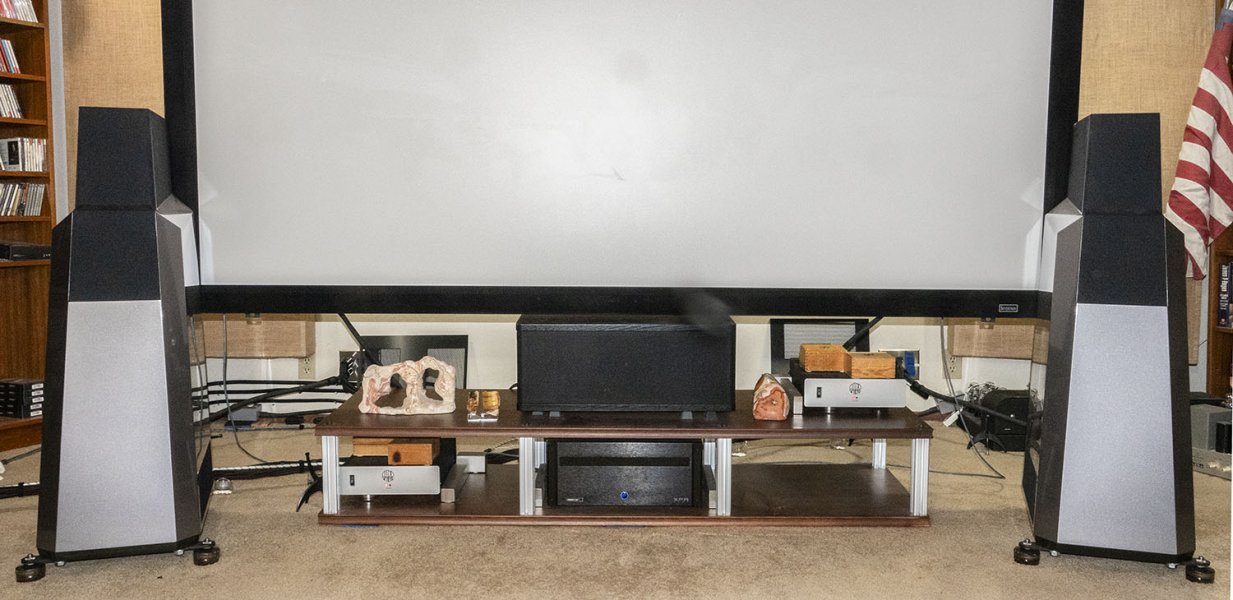
Do recall that I'm a 'slow-hearing' GEA if at all, so it'll be a week or 2 before I decide (again) that these are keepers.. So far, they sound excellent.
* I'm reasonably sure this is NOT a first-order filter, so whatever linearity the bottom octaves had is shot to smithereens.. Oh well...
** All other caps considered were physically too large.
My pair of Simaudio/Moon 400Ms have been in the musicroom gathering dust, so after one of my first-line poweramps decided not to turn on, I reinstalled the Moon 400Ms and set a 100Hz hi-pass filter in the preamp*. The system, overall, still sounded excellent, and then (back into my tweaking mode of years ago, apparently) I thought about how easy these amps would be to add a little very-high-quality PS capacitance--say, 0.33/200 'propylene-and-foil Audiocap Thetas**--wired directly to the rail-Voltage conductors of the output transistors...16 times.. I let that system--sounding very nice--percolate for a day and then noticed my carton of A-S Class-Ds growing old in my mess of a musicroom, so I removed the pair of 400Ms and installed the Ds.. (I also removed the third 400M that was driving the CC speaker and returned the CC to the 300-Watt channel of my Emotiva multichannel poweramp)..

Do recall that I'm a 'slow-hearing' GEA if at all, so it'll be a week or 2 before I decide (again) that these are keepers.. So far, they sound excellent.
* I'm reasonably sure this is NOT a first-order filter, so whatever linearity the bottom octaves had is shot to smithereens.. Oh well...
** All other caps considered were physically too large.
Last edited:
"The reason is by generating only odd orders, you are working with a cubic function and so you have two advantages:'"[emphasis added] I agree with this bit, please consider there is always an exponent to exponential decay (hence the term) and cubic works much better than quadratic. As best I can make out, Cheever, Geddes, Hiraga and so on did not have access to amps that expressed the cubic exponent as they do not seem to mention it at all. Boyk and Sussmann are correct but the conclusion "... not desirable" (wherever that came from), is incorrect. The reason is by generating only odd orders, you are working with a cubic function and so you have two advantages:
1) distortion falls off at a faster rate as the order of the harmonic is increased
2) the 3rd easily masks those higher orders- better than seen in an SET.
Now if you do some measurements you find something interesting: the odd orders in a circuit like an SET have higher amplitude than you see in the circuit is fully differential as I've pointed out before. Since in both cases, the lower orders are masking the higher orders, the higher orders are inaudible. So which is better at that point, the one with higher distortion or the one lower?? And by lower I mean well over an order of magnitude. Quite often its over two orders of magnitude.
The bit about the tape machines- the third harmonic is there regardless of the head driver, most of which are single-ended. Its a function of the tape head magnetics influenced by the bias signal (used to help keep the head linear). Feedback will create higher orders IF the feedback node is non-linear. If you look at most amps made within the last 80 years, they almost all have this problem, despite its actually being easily avoided. At any rate, all of my studio machines have single-ended record head drivers.The Ampex 351 tape electronics are entirely single-ended on the record side with no feedback, but the 3rd harmonic is still the dominant distortion product.
I agree with your assessment of recording media. The quality of the recording really has little to do with the media and everything to do with the skill of the recording engineer. Regardless, I suspect many of the recordings we both hold dear were made with analog tape.
This is completely BS, Ralph and you know it. It is WELL known that odd orders are more offensive sounding (other than third), with 7th and above being particularly nasty sounding. Also, having only odd orders puts the spacing greater between harmonic peaks and there is no masking whatsoever taking place. It is well known as well that the closer to the fundamental the greater the masking (i.e. 2nd is by far the best at masking subsequent harmonics). You might be able to sell that to your uneducated customers but not to me. NO ONE considers odd order only to be a good sonic pattern (at least those who have taken the time to think about it). Even very low levels of distortion will be audible...and still have a high Gm and Cheever metric.
From Keith Howard in Stereophile:
" Patterns 3 and 4 comprise, respectively, the odd- and even-order harmonics only "
"Pattern 3 was unpleasant, adding an edge to the sound that would surely become fatiguing over extended listening. Pattern 4 wasn't as bad, but there was still something unnatural about it. "
Pattern 3, odd only harmonics was the worst sounding of the patterns Keith overlaid on his recordings. Pattern 4, even only, was not as harsh (thus confirming the even harmonics are not as detrimental as the odd ones) but still not right.
"Pattern 1 represents an ideal Hiraga pattern of declining harmonic amplitudes, albeit at high level. Pattern 2 mimics Pattern 1 but with all the harmonics (down to the self-imposed –100dB limit) at 20dB lower amplitude."
"Pattern 1 added a distinct "dirtiness" to the sound that was not unpleasant but did change the instrumental timbre and diminish the sound's sense of fidelity—there was something clouding the sound. Pattern 2 was much better, with the closest sound to the undistorted reference"
Pattern 1 would be a SET with either quite high distortion or being pushed close to clipping (of course as Cheever demonstrated, the SPL level could be high enough to offset the audibility) and Pattern 2, the closest to the reference (an unadulterated recording) is a better SET or one kept well within it's limits.
Note also what Keith has to say about the Gedlee metric Gm: "GedLee metric values between 1 and 3 are supposed to correspond with subjective ratings of "barely perceptible but not annoying," with values of less than 1 indicating that the distortion is imperceptible. On this basis, none of these distortion patterns should be audible, despite their high harmonic amplitudes, but note that Pattern 3 has easily the highest Gm value, despite having a significantly lower THD than Pattern 1."
And wouldn't you know it, Pattern 3, odd orders only, was easily the worst Gm...Geddes had a quite good correlation between sound quality responses and his metric in the limited data set he generated for his papers.
Now, obviously, these levels of odd order are much higher than what your amps are making but it doesn't change the fact that these are OFFENSIVE sounding patterns and yours probably don't fall off exponentially...very few amps can make that claim in the real world. This means you still have odd harmonics, without their partnering higher even one before, that are audible and demonstrably poor sounding.
"Now if you do some measurements you find something interesting: the odd orders in a circuit like an SET have higher amplitude than you see in the circuit is fully differential as I've pointed out before. "
This is completely irrelevant...it doesn't matter if the SET has higher odd orders as long as there are even higher even orders coming before it. That is what both Geddes and Cheever's metrics conclude as well. Even D.E.L Shorter's inadequate metric tells a similar story. It is the relationship that matters and the pattern. What matters is that with push/pull and differential circuits you cancel out the even harmonics and this has sonically detrimental consequences. What also matters is that feedback creates higher order harmonics as it reduces the masking of beneficial, basically sonically benign, low order harmonics. What Boyk and Sussmann confirmed is that a signal modulated noise floor, as posited by Norman Crowhearst, shows up in simulation and so even if you add tons of feedback and push all of the harmonics down into the "noise"...it is not really noise and does damage to our perception still.
No one is debating that too much distortion (even 2nd order) will damage sound quality. Good SETs, run in their limits, will produce more or less the right pattern at levels, as Keith Howard put it "closest sound to the undistorted reference".
Actually, no, its not BS at all, although I readily agree unmasked odd orders are unpleasant. If you are being so bold as to call BS on me and that I'm trying to deceive someone (otherwise calling me a liar), its not a stretch here to state that you simply do not know what you're talking about (no judgement...). So maybe back down the rhetoric??This is completely BS, Ralph and you know it. It is WELL known that odd orders are more offensive sounding (other than third), with 7th and above being particularly nasty sounding. Also, having only odd orders puts the spacing greater between harmonic peaks and there is no masking whatsoever taking place. It is well known as well that the closer to the fundamental the greater the masking (i.e. 2nd is by far the best at masking subsequent harmonics). You might be able to sell that to your uneducated customers but not to me. NO ONE considers odd order only to be a good sonic pattern (at least those who have taken the time to think about it). Even very low levels of distortion will be audible...and still have a high Gm and Cheever metric.
You should probably listen to a differential amplifier before making such statements. You may have noticed that our preamps are fully balanced and differential and carry a trademark to that effect; somehow they get good reviews and awards as do our amps, which are also fully differential and balanced.
BTW our class D just got an award from HiFi+. So you have to square all this with the statement you're making above. Obviously there's something wrong with the picture you present; a pragmatic individual would simply realize that an incorrect conclusion had been drawn (for example, see if you can think of a way that the 3rd can be masking higher ordered harmonics...). If the statement you were making above were true, I think we might both agree that our tube amps and preamps would sound solid state and 'nasty' as you put it. But they don't, so something else is going on. Apply Occam's Razor and you'll see this is so. Cheever, et al simply didn't have the whole picture or didn't present it. I don't know which and don't care; its patently obvious that there's more to it. Perhaps something that can be heard but not measured?
No one is debating that too much distortion (even 2nd order) will damage sound quality
Too much and lower level detail is obscured by the distortion. All SETs I've ever encountered have this problem which makes them more musical instruments than musical reproducers.
I have the utmost respect for both gentlemen here. Might I suggest that calling someone else’s comments “BS and they know it”, is disrespectful and does nothing to advance the high-level discourse in these complicated ideas. Both of you have a lot of knowledge and experience to inform many of us. Imho
If you have only odd order distortion they are unmasked, Period. Show me literature to the contrary or stop making the claim. 3rd doesn’t “stretch” to cover 5th etc. This is why it’s so audible and Keith Howard commented as he did.Actually, no, its not BS at all, although I readily agree unmasked odd orders are unpleasant. If you are being so bold as to call BS on me and that I'm trying to deceive someone (otherwise calling me a liar), its not a stretch here to state that you simply do not know what you're talking about (no judgement...). So maybe back down the rhetoric??
You should probably listen to a differential amplifier before making such statements. You may have noticed that our preamps are fully balanced and differential and carry a trademark to that effect; somehow they get good reviews and awards as do our amps, which are also fully differential and balanced.
BTW our class D just got an award from HiFi+. So you have to square all this with the statement you're making above. Obviously there's something wrong with the picture you present; a pragmatic individual would simply realize that an incorrect conclusion had been drawn (for example, see if you can think of a way that the 3rd can be masking higher ordered harmonics...). If the statement you were making above were true, I think we might both agree that our tube amps and preamps would sound solid state and 'nasty' as you put it. But they don't, so something else is going on. Apply Occam's Razor and you'll see this is so. Cheever, et al simply didn't have the whole picture or didn't present it. I don't know which and don't care; its patently obvious that there's more to it. Perhaps something that can be heard but not measured?
Too much and lower level detail is obscured by the distortion. All SETs I've ever encountered have this problem which makes them more musical instruments than musical reproducers.
What makes makes you think I haven’t heard differential circuits? I have owned all kinds of gear…including true balanced stuff like BAT and Einstein and circlotron amps. I find SET to be more authentic and less synthetic sounding.
Harmonic distortion terms lead (mathematically and physically) to intermodulation distortion (IMD) products when more than one signal frequency is present. Low odd-order IMD products fall near the original frequencies where they are readily masked. Even-order IMD products fall far away and are not masked. Thus whilst higher odd-order products may be obnoxious, lower-order terms tend to be masked and relatively benign. I believe Ralph has been consistent in stating that viewpoint. Single-ended designs, SET or otherwise, tend to be dominated by second-order distortion which is more "benign" to listeners. Various folk (Pass etc.) have shown that adding small amounts of 2HD even enhances the sound to some (most? I do not know how large the studies) listeners. A case of not being faithful to the source sounding "better" to the listener. In that case, very low distortion is no longer a virtue.
This discussion about distortion signature is interesting and educational, but let's keep it civilized 
Perhaps not every SET, but in general I agree.
I find SET to be more authentic and less synthetic sounding.
Perhaps not every SET, but in general I agree.
Last edited:
just curious if your listening impressions are from the latest iteration of the LS1be with the SB1 subs (the review is 2011 and clearly there have been improvements since then). Sorry for the OT, but perhaps Grimm's use of (6) Class D amps has some relationship to the original topic here.Funny you mention Keith Howard. I just re-read his review of the Grimm LS1 and fully agree with his comments. Apart from the (smart) baffle shape, it's a ridiculously expensive system that doesn't draw you into the music.
just curious if your listening impressions are from the latest iteration of the LS1be with the SB1 subs (the review is 2011 and clearly there have been improvements since then). Sorry for the OT, but perhaps Grimm's use of (6) Class D amps has some relationship to the original topic here.
Yes, my listening impressions are purely based on a 'full monty' LS1be setup including the MU1.
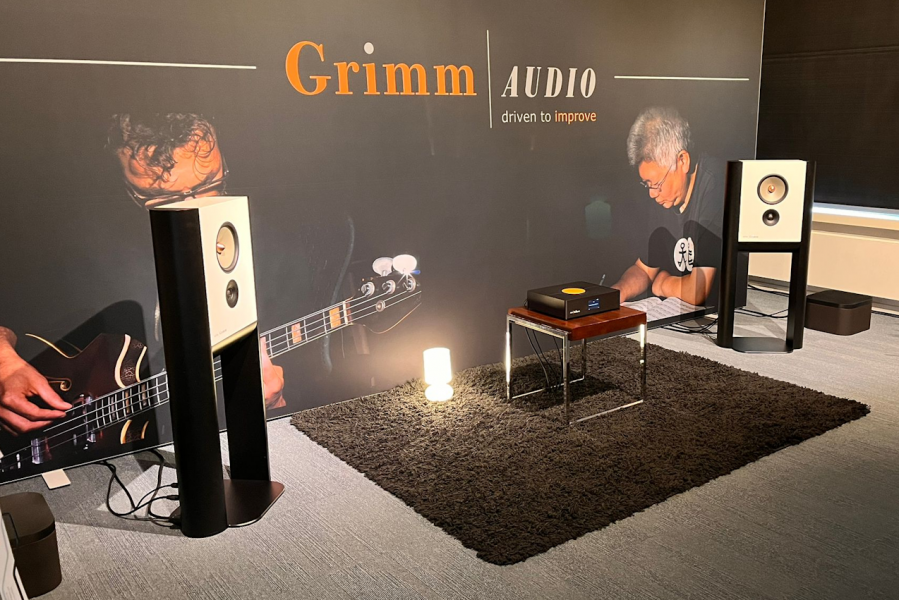
This setup costs about 50k I believe... and honestly, I wouldn't even pay 10k for it.
No doubt it's fine for monitoring tasks in studios, but definitely not my cup of tea when it comes to 'enjoying music'
Overall, I prefer the Kii SEVEN, which sounds more coherent.
Last edited:
Only when you inject enough to be audible. Studies have shown that up to 2% 2nd order is inaudible. The only odd order harmonic that is not unpleasant is 3rd.Harmonic distortion terms lead (mathematically and physically) to intermodulation distortion (IMD) products when more than one signal frequency is present. Low odd-order IMD products fall near the original frequencies where they are readily masked. Even-order IMD products fall far away and are not masked. Thus whilst higher odd-order products may be obnoxious, lower-order terms tend to be masked and relatively benign. I believe Ralph has been consistent in stating that viewpoint. Single-ended designs, SET or otherwise, tend to be dominated by second-order distortion which is more "benign" to listeners. Various folk (Pass etc.) have shown that adding small amounts of 2HD even enhances the sound to some (most? I do not know how large the studies) listeners. A case of not being faithful to the source sounding "better" to the listener. In that case, very low distortion is no longer a virtue.
Like all products…there are well executed ones and poorly executed ones.This discussion about distortion signature is interesting and educational, but let's keep it civilized
Perhaps not every SET, but in general I agree.
Professor Don. I prefer to the Pass sound as polite.Harmonic distortion terms lead (mathematically and physically) to intermodulation distortion (IMD) products when more than one signal frequency is present. Low odd-order IMD products fall near the original frequencies where they are readily masked. Even-order IMD products fall far away and are not masked. Thus whilst higher odd-order products may be obnoxious, lower-order terms tend to be masked and relatively benign. I believe Ralph has been consistent in stating that viewpoint. Single-ended designs, SET or otherwise, tend to be dominated by second-order distortion which is more "benign" to listeners. Various folk (Pass etc.) have shown that adding small amounts of 2HD even enhances the sound to some (most? I do not know how large the studies) listeners. A case of not being faithful to the source sounding "better" to the listener. In that case, very low distortion is no longer a virtue.
i tried to resist.
Dr. Olive has claimed to have proven that listeners prefer lower distortion. You proffer that people like distortion. You can understand why I find those positions at odds.
Last edited:
Similar threads
- Replies
- 13
- Views
- 1K
- Replies
- 94
- Views
- 10K
- Replies
- 20
- Views
- 4K
- Replies
- 58
- Views
- 7K
- Replies
- 9
- Views
- 1K
| Steve Williams Site Founder | Site Owner | Administrator | Ron Resnick Site Owner | Administrator | Julian (The Fixer) Website Build | Marketing Managersing |







